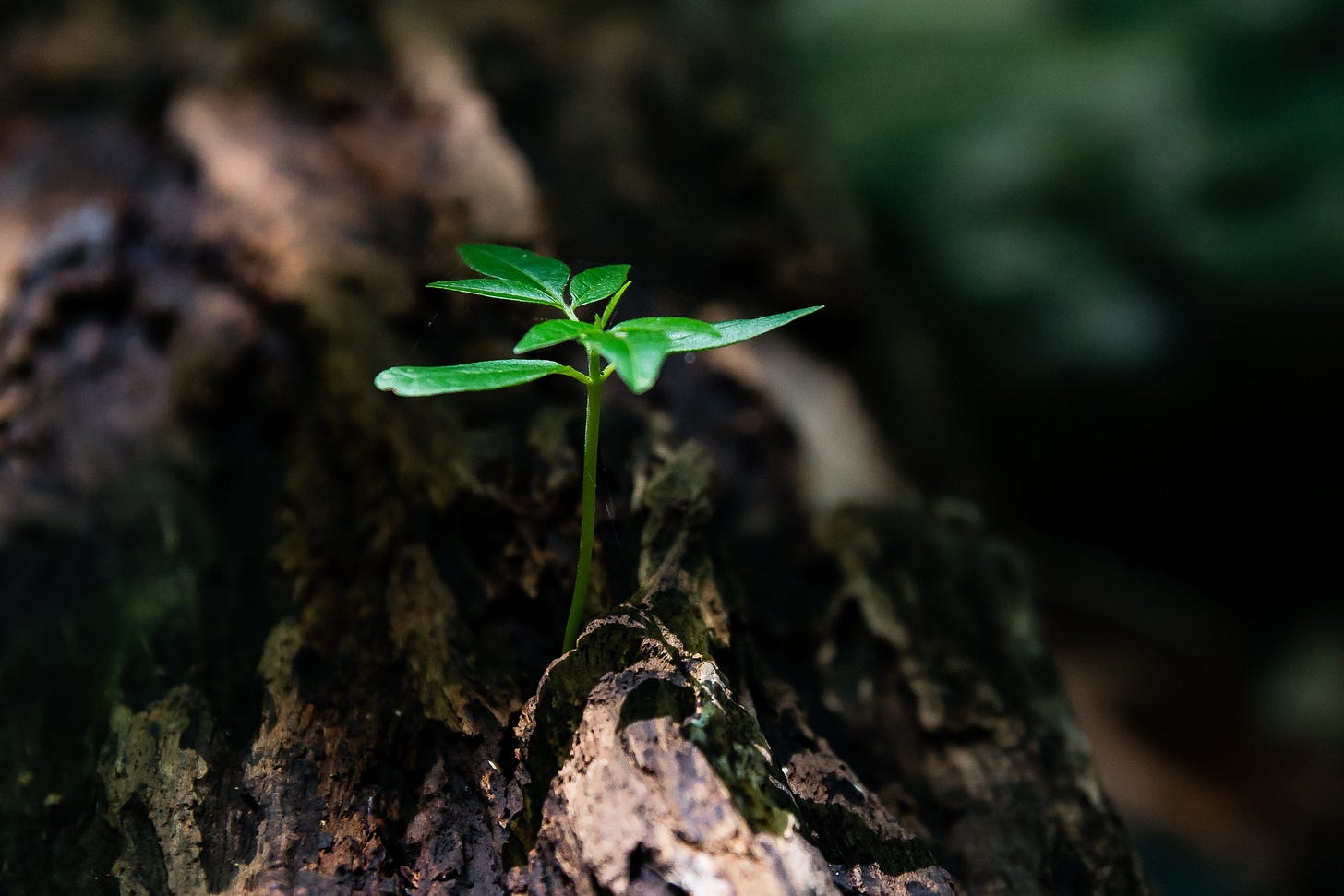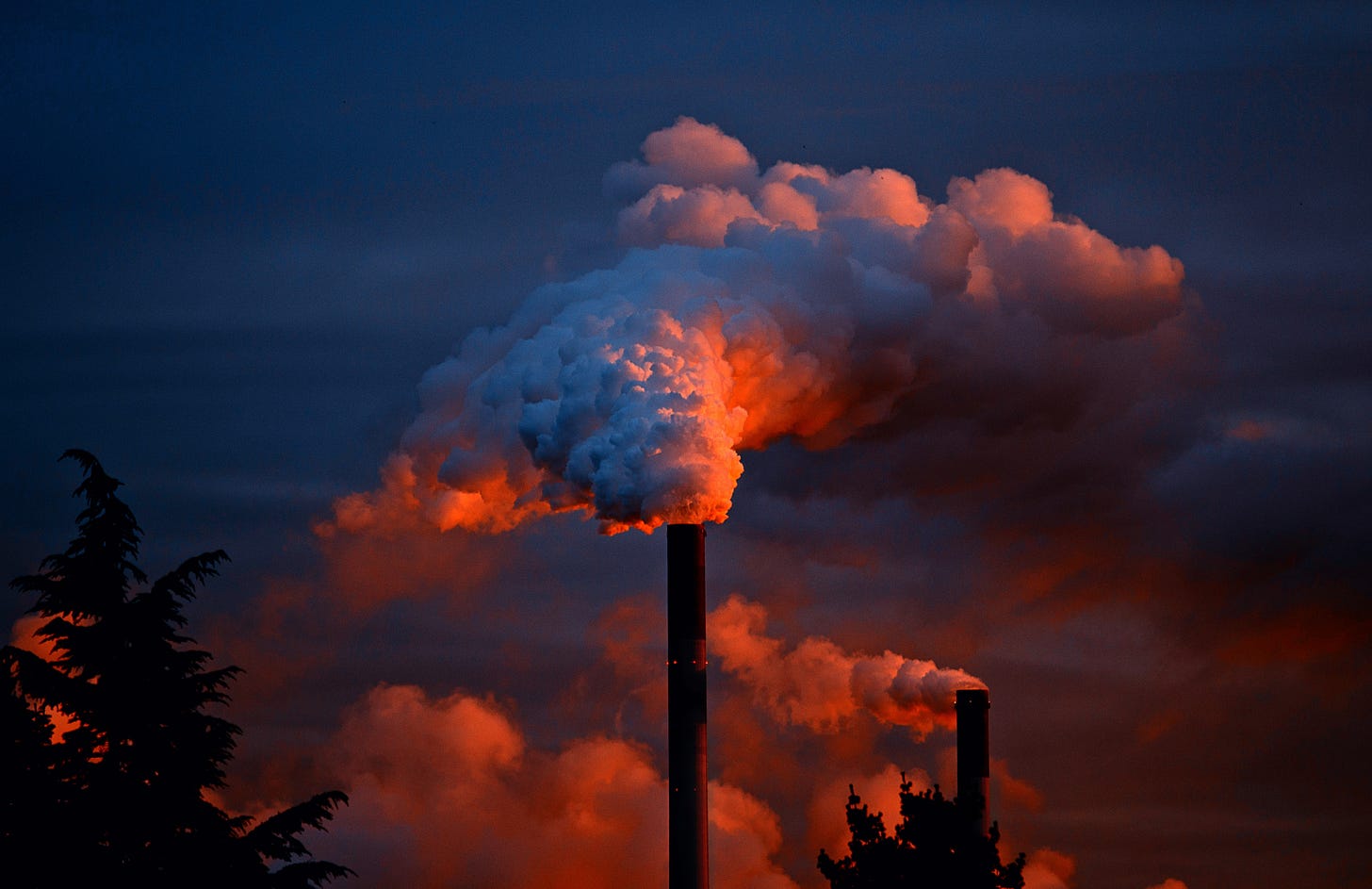I Heat My Home with Methane
Reflecting on not calling it 'natural gas'; quote of the day; books for transformation; and Friday Five - 5 top greenhouse gases
Welcome! I am Jessica Hetherington, and this newsletter is about faith and climate action. You can subscribe by clicking here:
Today’s Reflection

Methane is one of the leading greenhouse gases contributing to global heating. As I outline below, while it doesn’t last as long as carbon dioxide in the atmosphere, it contributes to global heating much more quickly; it is 80 times more potent over a 20-year period than carbon dioxide.1 The leading cause of methane emissions in the world is agriculture, particularly industrial agriculture, which relies on large-scale factory farming operations and technologies. (I am not referring to small-scale farmers, in North America or in the global South. I will be writing a longer essay on that at a later time).
Another leading cause, however, comes from the oil and gas industry. In Canada, about 13% of our greenhouse gas emissions are methane. Out of that amount, 21% comes from oil and gas. This includes what we use to heat our homes.
Often when we think of methane (if we think of it at all), we think of cow burps. Cows and other ruminants chew cud and, as they digest it, they emit methane into the atmosphere. This is one key reason why the current level of industrial beef farming (and other ruminants) is so deleterious for the climate.
However, how often do you think of the natural gas that heats many of our homes as methane? Although I have been growing in awareness about the climate crisis and greenhouse gases over the last few years, and even though I knew, on one level, that the natural gas that heats my own is, in fact, methane, the trick in calling it “natural gas” is that I haven’t really made the connection between the data in the first paragraph, above, and my house. I know that I need, when I can afford it, to move to more renewable forms of energy for my home, including solar panels and sustainable sources of electricity. But, somehow, saying “I heat my home with methane” rather than “I heat my home with natural gas” brings the potency of methane, and its problem, into my awareness much more clearly.
I heat my home with methane. And that is a big problem.
The problem, however, isn’t individual; it isn’t just me who heats my home this way; most of us in Canada do. In 2021, about 2/3 of Canadian homes, businesses and other buildings used methane for heat. In the US, nearly half of homes are heated with methane.
If you didn’t realize that before, it’s ok. It’s not you; it’s the oil and gas industry. They prefer to refer to the gas in the lines to our houses as natural gas. This is the current form of climate denialism in our world today; for the fossil fuel industry to greenwash methane as a ‘natural gas’ that provides ‘clean’ energy. Yet, as David Suzuki says, it “isn’t natural, and it’s not a climate solution.”2
Calling it natural gas obscures the fact that the gas heating our homes is a fossil fuel, and is primarily methane in its composition (there are a few other gases in there, in much smaller proportions). Calling it natural makes it seem more benign than carbon dioxide, but it isn’t. Methane is not climate-friendly, and it is not a solution, in any way, for moving away from oil in our world. The only solution to reduce greenhouse emissions is to make the immediate and radical transformation to renewable energies. We also need to make the immediate and radical transformation to using much less of all energy sources, too.
This is the current form of climate denialism in our world today; for the fossil fuel industry to greenwash methane as a ‘natural gas’ that provides ‘clean’ energy.
For me to be able to feel empowered, and to be honest with myself, with others and with God, I need to recognize something for what it is, and be willing and able to call it what it is. We know, in our faith tradition, how important naming is, and how important truth-telling is. Naming the gas in the lines to our homes as methane assists us in our truth-telling; it assists us in naming a thing what it is so that we can look at it accurately and honestly, and come to terms with what it means, for our lives, for the lives of others and the Earth itself.

That I heat my home with methane brings home – literally - the reality that how I stay warm in the winter is having a direct and immediate negative impact on the climate and its systems. That I heat my home with methane means that I have a responsibility to seek changes, individually where I can, and especially politically, in demanding legislative changes across the board.
This reflection isn’t meant to be a guilt-trip for me or any of my readers. The reality of the climate crisis is complex and systemic. We are complicit, yes, but the solutions to the crisis are not, and can never be, individual.
By stating that I heat my home with methane, I am being truthful about one (more) way that my actions are harmful to the Earth. While I am not in a position to be able to afford to make a climate-friendly change (in my part of the world, that would mean a heat pump using electricity) right now, I am in the position to learn more about the issue, and work at the political level for government changes to law and policy regarding the oil and gas industry, calling for changes to construction and retrofitting, and making rebates and other financial incentives available to landlords and homeowners to transition their homes off methane and one renewable sources of heating.

Quote for the Day
“Loving nature and living frugally are excellent ways to prepare ourselves for the change that our society needs and that the religions can help bring about: a paradigm change. This must be a change in our most basic sense of the good life.”
~Sallie McFague3
Books for Transformation
Contextual Theology for the Twenty-First Century, ed. Stephen B. Bevans and Katalina Tahaafe-Williams (Eugene, OR: Pickwick Publications, 2011)
I really do enjoy going back into my personal library (the one you can see behind me in Zoom meetings) and look for books that you may find helpful in your reflections on the climate crisis and how we can respond, or even consider the issue, in light of faith. This book is one that I used in a course I taught on understanding contextual theology in the Canadian context. Co-editor Bevans defines contextual theology in an earlier book as:
“a way of doing theology in which one takes into account: the spirit and message of the gospel; the tradition of the Christian people; the culture in which one is theologizing; and social change in that culture…”4
While such contextualization is important to be acknowledged in any theological reflection, Bevans is calling for making the uniqueness of each context a central point for consideration, to discover what richness we can gain into our faith and the world that we wouldn’t necessary discover otherwise. With this newer volume, the contributing authors help us to think about what the 21st-century church looks like today, how theology is being expressed around the world, and how the mission of the church can be informed and re-formed. While the book does not address the climate crisis or broader ecological crisis explicitly, the ideas in it can guide people in gaining more insight into how the climate crisis is understood in varying contexts, and how best we might respond as people of faith.
It’s Not That Radical: Climate Action to Transform Our World, by Mikaela Loach (London UK: Penguin Random House, 2023)
Well, there are reasons that my personal library keeps expanding, and this is one of them! Loach is a 25-year-old climate activist and medical student located in Edinburgh, Scotland. This book calls for climate justice that challenges traditional White environmentalism, capitalism, police brutality and more. It is pegged as a call to action (how could I resist?) and a book of hope (ditto!). I cannot wait to read it. I ordered my copy directly from Blackwell’s in England, for only $26 CAD, free shipping. I hope that you will consider ordering a copy, too.
Friday Five
Five Greenhouse Gases
The way that the world is made is fascinating; understanding its various aspects is a way of understanding God and God’s good creation. It is also necessary that we educate ourselves so as to be more effective in responding to the climate crisis. This week’s Friday Five offers you a brief overview of the five top greenhouse gases impacting our climate today. We should remember that greenhouse gases are not bad in and of themselves; they are naturally occurring gases on the Earth, and contribute in varying ways to the functioning of Earth’s biosphere. It is through human activities that they have become disproportionately prevalent in the atmosphere, leading to global heating.
Carbon Dioxide (CO2) As most of us are aware, carbon dioxide is the most prominent of the greenhouse gas (GHG) emissions in the climate emergency today. This is due primarily to the burning of fossil fuels. Trees and other plants are carbon sinks that absorb carbon dioxide. The clearcutting and burning of forests around the world also contributes to global heating. CO2 stays in the atmosphere for between 300 and 1000 years, which means that the heating it causes remains for that length of time.
Methane (CH4) Methane is emitted through the production of coal, ‘natural gas’, and oil; industrial agriculture; and the decay of organic waste in solid waste landfills. It is more potent than CO2, but only lasts in the atmosphere for around 10 years. This means that aggressively tackling our methane emissions can have a more immediate impact on the rate of global heating.
Nitrous Oxide (N2O) Nitrous oxide is emitted during agriculture and other land use; industrial activities; the burning of fossil fuels; and the treatment of wastewater. It stays in the atmosphere for 121 years. It is, however, far more potent than CO2. “The impact of one pound of N2O on warming the atmosphere is 265 times that of 1 pound of carbon dioxide.”5
Fluorinated Gases Fluorinated gases include, among others, hydrofluorocarbons (HFCs), perfluorocarbons (PFCs), and sulfur hexafluoride (SF6). While these are emitted in much smaller quantities than the ones listed above, they are far more potent than the GHGs already listed, and have much longer lifespans in the atmosphere. While they may sound unfamiliar, they are used in common products all the time. HFCs are the refrigerant gases, those in aerosol cans, solvents, and fire retardants. They have a global warming potential (GWP)6 that is 12,400 times that of CO2 over a 100-year span, and last for 1-270 years in the atmosphere. PFCs are a by-product of producing aluminum, and used in producing semiconductors. Their GWP is 10,000 times that of CO2; they last for between 2,600-50,000 years in the atmosphere. SF6 is used in processing magnesium and making semiconductors. It has the highest GWP measured so far, at 23,500 times that of CO2, and lasts for around 3200 years.
Water Vapour (H20) Wow! I am glad that I am disciplined to a ‘Friday Five,’ and not a lesser number. While it was obvious once I read it, I simply didn’t consider water vapour to be a GHG contributing to global heating before. Like all of the other GHGs, water vapour is not a bad thing. Water vapour, when water evaporates as a gas into the atmosphere, allows the Earth to be warm enough to be livable. The same is true, to varying degrees of all the other GHGs, too. Water vapour contributes to global heating too, but not at all in the same way as the ones above. While the increased emissions of CO2, CH4, N2), and fluorinated gases is directly due to human activities, the increase in H20 is due to the consequences of those human activities. As we heat up the planet, the level of water vapour goes up, through increased evaporation. Increased water vapour is having an amplifying effect on the global heating caused by the other GHGs.

Coming Events
May 21 – Preaching at Riverside United Church, Ottawa ON. In person at 10:30 am and online here. Sermon: “We are Sent Out With Joy” (Luke 24:44-53)
May 28 – Preaching at Trinity United Church, Ottawa ON. In person at 10:00 am and online here. Sermon theme: When fires are damaging the Earth, what do the fires of Pentecost mean?
Please join me in worship!
That is all for this week. May you all feel the blessing and nurturing of the Earth community this weekend, and feel moved to take climate action.
David Suzuki et al., “Fossil gas isn’t natural, and it’s not a climate solution,” https://davidsuzuki.org/story/fossil-gas-isnt-natural-and-its-not-a-climate-solution/?gad=1&gclid=Cj0KCQjwmZejBhC_ARIsAGhCqncjyAg1VsQvG8PZC_81YSfPguGFlE9XC-XZGeAiA-R-zBT2veTePf4aAnlOEALw_wcB. Accessed May 18, 2023.
Sallie McFague, Life Abundant: Rethinking Theology and Economy for a Planet in Peril (Minneapolis: Fortress Press, 2001), 199.
Stephen B. Bevans, Models of Contextual Theology (Maryknoll: Orbis Books, 1992), 1.
“Overview of Greenhouse Gases,” United States Environmental Protection Agency, https://www.epa.gov/ghgemissions/overview-greenhouse-gases . Accessed May 18, 2023.
“The Global Warming Potential (GWP) metric examines each greenhouse gas’s ability to trap heat in the atmosphere compared to carbon dioxide (CO2). We measure this over a specified time horizon. Often, we calculate GHG emissions in terms of how much CO2 is essential to produce a similar warming effect over the chosen time horizon. This is the carbon dioxide equivalent (CO2 eq) value. We calculate it by multiplying the amount of gas by its accompanying global warming potential (GWP).” https://www.canada.ca/en/environment-climate-change/services/climate-change/greenhouse-gas-emissions/quantification-guidance/global-warming-potentials.html. Accessed May 19, 2023.







